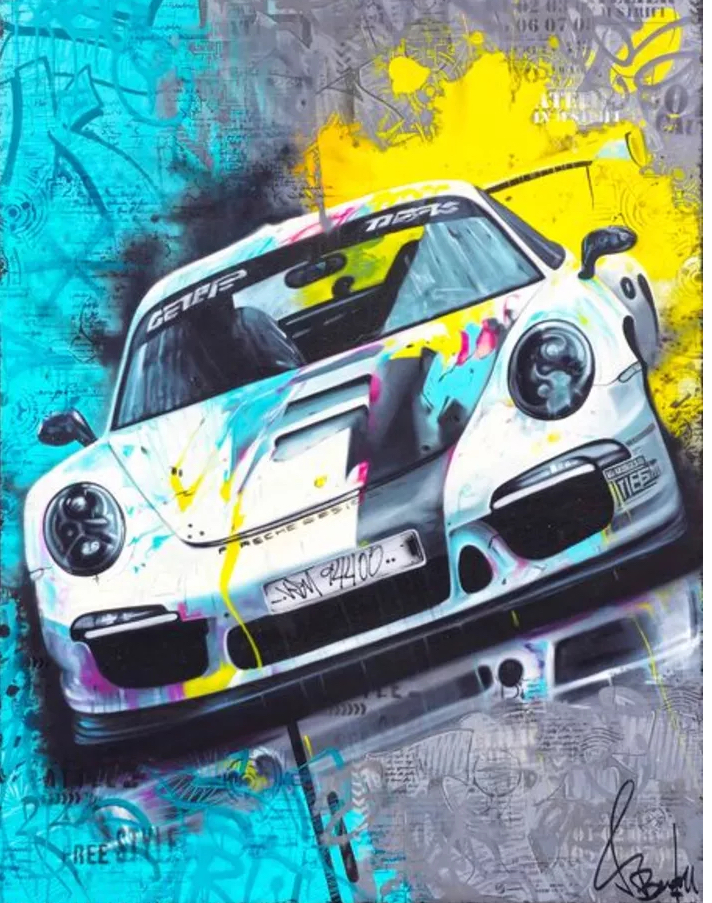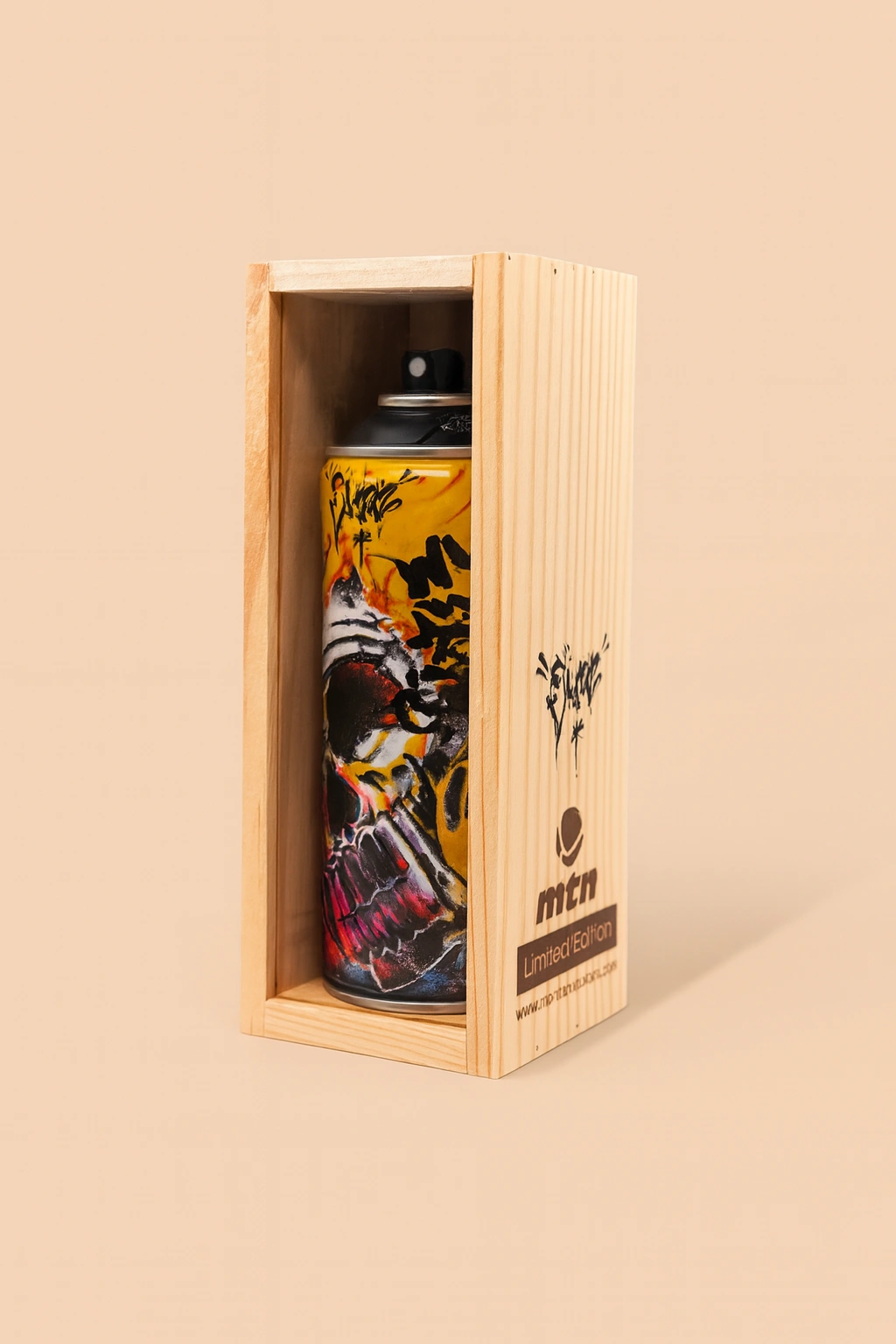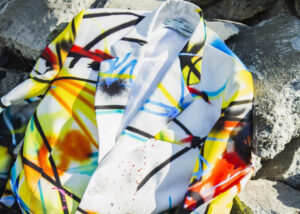Vincent Bardou, a prominent figure in the world of contemporary street art, has consistently pushed the boundaries of his craft. His 2024 creation, the Porsche Art Car, is a striking example of how urban art can intersect with luxury design to produce something unique and thought-provoking. By reimagining the iconic Porsche through a graffiti-inspired lens, Bardou’s work challenges conventions, blending the rebellious nature of street art with the prestige and precision of automotive craftsmanship.
The Intersection of Street Art and Automobiles
At first glance, Bardou’s Porsche Art Car appears as a vibrant celebration of the automobile—a modern-day status symbol. However, it is more than a mere tribute to luxury vehicles; it is a commentary on the dualities of modern life. The sleek, engineered precision of the Porsche contrasts sharply with Bardou’s chaotic, graffiti-inspired aesthetic, creating a visual tension that draws the viewer in.
The car, a symbol of power, wealth, and speed, is enveloped in the raw, unapologetic language of street art—a medium traditionally associated with rebellion and counterculture. This juxtaposition invites questions: Is Bardou subverting the idea of luxury by merging it with a gritty, urban art form? Or is he elevating graffiti by placing it within the realm of high-end design?
Artistic Vision and Execution
Bardou’s artistic style is characterized by a fusion of vivid colors, bold strokes, and intricate details. His work often incorporates elements of pop culture, blending them seamlessly with the raw energy of graffiti. The Porsche Art Car is no exception. The vehicle’s sleek lines serve as a canvas for Bardou’s dynamic artistry, transforming a static object into a living, breathing work of art.
The Use of Color
Bardou’s color palette for the Porsche Art Car is both striking and deliberate. Bright, neon hues dominate the composition, creating a sense of movement and vitality that echoes the car’s inherent dynamism. These colors clash and blend, mimicking the energy of a bustling urban environment. The result is a visual symphony that feels alive, as though the car could drive straight off the canvas into the heart of a city street.
Graffiti as a Medium
Graffiti has long been a controversial art form, dismissed by some as vandalism and celebrated by others as a powerful mode of self-expression. By incorporating graffiti into the Porsche Art Car, Bardou challenges these perceptions, asserting its legitimacy as a fine art medium. The layers of spray paint and intricate patterns invite viewers to reconsider their preconceptions, blurring the lines between high art and street culture.
Symbolism in the Porsche Art Car
The Porsche Art Car is rich with symbolism, much of which emerges from the interplay between the car’s form and Bardou’s artistic choices. The Porsche, as an object, represents speed, wealth, and modernity. Its polished exterior and precise engineering make it an emblem of control and mastery.
In contrast, Bardou’s graffiti aesthetic conveys chaos, spontaneity, and defiance. The vibrant, overlapping patterns and textures suggest a world in flux, where boundaries are constantly being tested. Together, these elements create a dialogue about power and freedom. Does the car embody freedom through its speed and performance, or is it constrained by its own image as a luxury commodity? Similarly, does the graffiti symbolize liberation, or is it limited by its association with subversion?
The Role of Luxury in Contemporary Art
Bardou’s Porsche Art Car also raises important questions about the role of luxury in contemporary art. By using a high-end automobile as his canvas, Bardou brings street art into an arena traditionally reserved for wealth and exclusivity. This move can be interpreted in several ways.
Subversion of Luxury
On one hand, Bardou may be subverting the idea of luxury itself. Graffiti, as an art form, has its roots in marginalized communities and often carries messages of resistance against authority and privilege. By covering a Porsche in graffiti, Bardou could be seen as reclaiming a symbol of affluence and repurposing it for a more egalitarian form of expression.
Elevating Street Art
Conversely, Bardou may be elevating street art by aligning it with luxury. In this interpretation, the Porsche Art Car becomes a statement about the legitimacy of graffiti as a fine art form. By placing street art on a pedestal—literally and figuratively—Bardou challenges the notion that it belongs only on the walls of urban landscapes.
Impression
The Porsche Art Car is not just an artistic statement; it is a cultural artifact that reflects the complexities of the 21st century. At its core, the piece embodies a collision of worlds: the sleek, corporate world of luxury automobiles and the vibrant, rebellious spirit of street art.
Consumerism and Art
In a consumer-driven society, the Porsche Art Car prompts viewers to consider the commodification of art. By placing graffiti—a traditionally anti-establishment art form—on an object of luxury, Bardou forces us to confront the ways in which counterculture can be appropriated and commodified. Is the car a celebration of street art, or does it risk reducing it to a decorative trend?
Urban Identity
The Porsche Art Car also speaks to the evolving identity of urban spaces. Cities are constantly changing, shaped by the forces of gentrification, globalization, and cultural exchange. Bardou’s fusion of graffiti and luxury reflects this dynamic, capturing the tension between preservation and progress, rebellion and assimilation.
Bardou’s Broader Artistic Vision
The Porsche Art Car is part of Vincent Bardou’s larger Art Car collection, which explores the intersection of automotive design and urban art. Each piece in the series builds on Bardou’s signature style, using cars as canvases to examine themes of speed, luxury, and city life.
What sets Bardou apart as an artist is his ability to adapt his graffiti-inspired aesthetic to a variety of contexts without losing its authenticity. Whether he’s painting a canvas, a wall, or a Porsche, his work retains its raw energy and cultural relevance. This adaptability is a testament to his skill as both a craftsman and a storyteller.
Critical Reception
The Porsche Art Car has been met with widespread acclaim from critics and collectors alike. Many have praised Bardou for his innovative approach and his ability to merge seemingly disparate worlds. The piece has been featured in prominent galleries and art platforms, further cementing Bardou’s reputation as a trailblazer in contemporary art.
However, the work has also sparked debate. Some critics argue that the fusion of graffiti and luxury risks diluting the rebellious spirit of street art. Others contend that Bardou’s use of a Porsche as a canvas reinforces elitist notions of art by associating it with wealth and privilege.
Final Thoughts
Vincent Bardou’s Porsche Art Car is a powerful example of how art can transcend boundaries and challenge conventions. Through its vibrant fusion of street art and luxury design, the piece invites viewers to reconsider their assumptions about power, identity, and the role of art in society.
Whether seen as a subversion of luxury, an elevation of street art, or a commentary on cultural tensions, the Porsche Art Car is undeniably thought-provoking. It reflects Bardou’s mastery as an artist and his willingness to push the limits of his medium. As part of his broader Art Car collection, it stands as a testament to the transformative power of creativity and its ability to spark dialogue in unexpected ways.
No comments yet.








